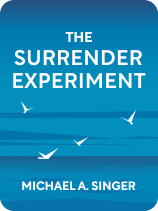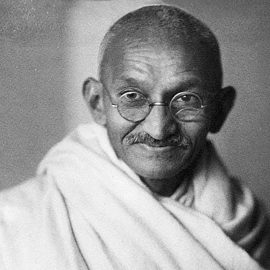

This article is an excerpt from the Shortform book guide to "The Surrender Experiment" by Michael A. Singer. Shortform has the world's best summaries and analyses of books you should be reading.
Like this article? Sign up for a free trial here.
Looking for an overview of Michael Singer’s The Surrender Experiment? What are the key takeaways and advice from the book?
In The Surrender Experiment, Michael Singer explains how to make your life exactly as the universe wants it to be. The book explains the process Singer discovered for surrendering to the opportunities life presents by trusting in the universe.
Keep reading for a brief overview of Michael Singer’s The Surrender Experiment.
Overview of The Surrender Experiment
Michael Singer’s The Surrender Experiment describes his 40-year journey from hippie college kid to CEO of a billion-dollar corporation—and attributes it all to saying yes to what life offered. Published in 2015, this book follows Singer’s #1 New York Times best seller, The Untethered Soul (2007), which explores spiritual methods for freeing the mind from limiting thoughts, emotions, and energy.
Michael “Mickey” Singer is an American spiritual teacher, motivational speaker, and author who founded the meditation and yoga center, Temple of the Universe, in Alachua, Florida. He’s a lifelong practitioner of meditation and yoga and a successful software developer. The Surrender Experiment tells the story of how Singer was able to bridge those worlds, expanding both beyond his wildest dreams, through a process of surrendering to the opportunities life presented.
The Principle of Surrender
Singer shows us what can happen when you let life, or the “universe,” do what it wants to do rather than you trying to make it do what you want. This is what he calls “surrender.” He explains that the universe is imbued with an intelligence that’s far beyond the limits of human understanding. Life has been evolving for billions of years. From the smallest embryonic cells to the vast planetary systems, the forces of life do exactly what they’re meant to do without our intervention. So, Singer reasons, it’s pretty presumptuous of us to think we should know what life should be doing and try to control it. He asks us to instead consider trusting that life knows exactly what’s supposed to happen and allowing it to naturally unfold.
In The Surrender Experiment, Michael Singer clarifies that surrendering doesn’t mean “dropping out” or being ambivalent about life, but rather it means fully diving into the flow of life. It also doesn’t mean giving up your free will—surrendering means aligning your will with the greater will of the universe. For example, if you’re presented with an opportunity to make some contribution to the world, it’s because life wants that to happen. You should stop to consider the bigger picture rather than decide based on what you like or want. Even if it’s something you don’t particularly want to do, you should recognize that life knows better than you do, and if you take the opportunity, your life will be better for it in ways you can’t always imagine. So the surrender experiment is ultimately an exercise in trust.
The Catalyst: Awareness of the Monkey Mind
Before Singer had his insights about surrendering to the flow of the universe, he was a typical college student whose annoying inner voice led him to meditation.
His surrender story begins in Gainesville, Florida in 1970. He describes his younger self as a “hippie” who was less than serious about his education and for some time lived in a Volkswagen van. He didn’t have a clear vision for his life and felt aimless at times. But a single event set his life on a whole new trajectory that he’s remained on to this day. This was an otherwise unremarkable experience, and yet it had a profound and permanent effect on his life.
During a conversation with his brother-in-law, an awkward silence caused Singer to mentally search for conversational topics to fill the lull. He then noticed that he was doing that in his mind, and found himself reflecting on his own thought process. This was the first time he’d ever consciously observed his own internal monologue, and he became fascinated with exploring that further. After that conversation, Singer began to regularly and consciously observe his own thoughts and to reflect on the distinction between his unconscious mental chatter and the part of himself that was noticing the chatter. He had the sense that his true self was the one recognizing the voice, not the chattering voice itself, and the more he noticed the chatter, the more he became annoyed by it and wanted to silence it.
(Shortform note: Buddhism makes the distinction between your thinking mind and your observing mind. Both of these are parts of your mind, but the mind that observes the thoughts is the one we’re less in touch with. Mark Manson, the author of The Subtle Art of Not Giving a F*ck, says in order to deal with negative emotions like fear and anxiety, we must learn to disidentify with the thinking mind. In other words, don’t think of those fearful thoughts as you; just recognize them as being there in your mind and then let them go.)
Trust the Universe
In The Surrender Experiment, Michael Singer describes one of his first chances to practice surrender, which came in the form of a teaching opportunity. Through a series of decisions to say yes when his mind was saying no, he would learn that the universe knew better than him what was meant for his life.
When Singer became fully immersed in his meditation practice, he lost interest in pursuing his graduate degree and decided not to finish it. But when his professors urged him to continue, he applied his method for surrender by discarding his preference (not wanting to continue school) and finishing his degree. This led to a colleague asking him to teach classes at a local community college. He didn’t want to teach; he just wanted to be alone on his land, lost in meditation. So again he was tempted to say no. But he reminded himself it wasn’t about what he wanted. Life was presenting this opportunity, so he surrendered and said yes despite great mental resistance.
| Go With the Flow Michael Singer’s idea of surrendering to what life wants in The Surrender Experiment mirrors Deepak Chopra’s assertion that true success comes from aligning with the spiritual energy of the universe that’s flowing through you. Chopra says trying to control external events in our lives is based in fear and gives us anxiety. However, when you connect with the spiritual realm, your life will naturally begin to flow with the energy of the universe, and this will bring you true success—a joyful life. Jay Shetty says this is why monks are the most peaceful, happy people in the world. They exist at all times in this state of harmonious flow with the energy of life. In Think Like a Monk, Shetty offers some advice on how to experience this flow. Some strategies he suggests are: – Explore your fears, asking yourself why you fear what you do. Continue asking “why?” until you’ve identified the deepest root of the fear. This will ultimately help you detach from those fears, and then let go of the need to try to control your environment. – Practice forgiveness and gratitude. Release the negative feelings you’re holding on to from the past, and shift your focus to what you’re grateful for in the present. – When you confront challenges in life, instead of thinking about what you need to do, think about how you need to be. For example, instead of thinking, “I need to confront this person and explain what they did wrong,” think, “I need to be patient and understanding in this interaction.” |
The Temple is Founded
The Surrender Experiment describes how the next turn of events would further reinforce for Michael Singer how devotion to a life of service can result in extraordinary events. His next act of surrender would result in his most beloved lifelong project and the embodiment of his life as service: the Temple of the Universe.
After the success of the previous retreat, Singer was asked to host another guru for a second retreat—an Indian saint called Ma Yoga Shakti, or Mataji. Again he mentally resisted, and again he ultimately surrendered and said yes. When Mataji arrived, Singer took her on a walk around his property. At one point on the walk, Mataji stopped suddenly and told him she felt a holy presence in that spot. She then said something that caught him completely off guard: She told him she could foresee that there would one day be a temple in that very spot. His immediate mental response was “absolutely not!” but by now he was able to quickly realize it wasn’t up to him, and he reminded himself of his new commitment to making his life an act of service.
(Shortform note: Ma Yoga Shakti, born in Varanasi, India in 1927, devoted her life to the service of humanity, and particularly to women. She was one of the first prominent female Hindu gurus and was a major contributor to the spread of yoga to the West. She died in 2011.)
Within months, Singer and his community began building The Temple of the Universe on his property. The first services were held in the Temple in the fall of 1975, and they continue to be held there regularly to this day. (Shortform note: As of 2022, the Temple of the Universe offers weekly Sunday services delivered by Singer, as well as meditation and chanting ceremonies, and free twice-weekly yoga classes.)
Make Your Life an Act of Service
In The Surrender Experiment, Michael Singer describes his need for finding a bigger purpose. His ego had drawn him toward meditation and yoga because of what it could do for him. But truly surrendering to life would mean acting in service of something greater than himself.
Since a regular community was now practicing meditation and yoga on his property, with him as the leading figure, Singer began seeking out spiritual gurus for their wisdom. By 1974, a young woman named Donna had moved into Sandy’s house; Donna urged Singer to contact a popular Indian guru named Baba Muktananda to ask him to visit Gainesville. Reluctantly, Singer surrendered and said yes. In the winter of 1975, he and Donna organized a weekend retreat for spiritual seekers to come to hear Baba speak. It was wildly successful. The venue was filled to capacity. Ultimately, as a result of this surrender, Baba Muktananda became Singer’s guru, and Donna eventually became his wife.
One of the most profound lessons Singer would learn from Baba was about the importance of acts of service. Observing how Baba devoted his life to serving others inspired Singer to embrace all the events that had transpired to change his life, because he had allowed life to do what it wanted, in the service of others. He realized he must view his whole life as an act of service.

———End of Preview———
Like what you just read? Read the rest of the world's best book summary and analysis of Michael A. Singer's "The Surrender Experiment" at Shortform.
Here's what you'll find in our full The Surrender Experiment summary:
- The story of how a hippie college kid became a wealthy CEO
- How to make your life exactly as the universe wants it to be
- How to free your mind from limiting thoughts, emotions, and energy






